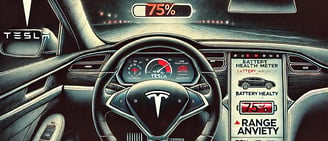The Hidden Costs of a Used Tesla: Battery, Resale, and Cold Realities
So, you’re considering a used Tesla—drawn in by the electric allure, the tech, and the dream of never stopping at a gas station again. But here’s the reality check: a used Tesla, especially one with miles on it, isn’t all high-fives and green energy. As the battery ages, so does the range, and replacing it isn’t cheap (we’re talking five figures). And while Teslas hold strong resale value now, that won’t last as newer models with better range and features hit the market. Before you buy, be sure you’re ready for the hidden costs and inevitable wear lurking behind that sleek design.


So you’re thinking about a Tesla. You’re mesmerized by the sleek design, the software updates, and the fantasy that you’ll save a mint on gas. But let's set something straight—owning a Tesla, especially an older one, isn’t just about plugging in and cruising. If you’re diving into the used Tesla market, there are a few things the fanatics, the brochures, and yes, even Elon himself, aren’t telling you. Let’s talk about what really happens to a Tesla over time, how the battery plays into the long game, and what the resale value looks like once those shiny new electrons start losing their spark.
Battery Deterioration: Not So “Set and Forget” After All
First off, let's address the Tesla battery itself. Look, every car depreciates, that’s a given. But Tesla’s batteries add a little twist to the story because they don’t just wear down like an old tire—they deteriorate in a way that hits both range and, ultimately, the car’s value. According to a study by NimbleFins, Tesla batteries retain about 90% of their capacity after the first 100,000 miles. Sounds good, right? Sure, until you realize that this 10% drop translates into real-world headaches. For a Model S with a 370-mile range, that’s a loss of nearly 40 miles per charge, and this isn’t some luxury you can just replace easily down the line.
Now, before you tell yourself that you can live with a small range decrease, know this: Tesla battery deterioration doesn’t just stop at 10%. It keeps going. A decade down the line, you’re likely looking at something closer to 80% capacity, especially if you bought one of those early models. And let's be real—if the battery's down to 80% and range anxiety sets in, that Tesla road trip dream starts to look a lot more like charging-stop purgatory.
The Price Tag of Battery Replacement: Not for the Faint of Heart
Here’s where we get to the hidden Achilles’ heel of used Teslas: battery replacement cost. If your Tesla battery decides to throw in the towel, the replacement can cost anywhere from $13,000 to $20,000 depending on the model and the severity of the replacement needed【source: MotorTrend】. That’s right. We’re talking about the price of a new Honda Civic just to keep your Model S on the road.
Now, Tesla doesn’t make it exactly easy to just pop into a local garage and get a new battery, either. Oh no, you’re locked into Tesla’s service network, and that means you’re at the mercy of their parts and labor costs. And here's a sobering thought: unlike gas engines that can chug along with a little TLC from any old mechanic, that Tesla battery is an all-or-nothing deal. When it goes, it goes.
Resale Value: That Sticker Shock is Going to Stick Around
Let’s not kid ourselves. Tesla has some of the best resale value in the car market. Why? Because Teslas are still the crown jewel of the electric car world, and they’re desirable enough to defy the usual depreciation trends. But here’s where things get interesting. If you’re thinking about buying a used Tesla, especially one from 2015 or 2016, you’re likely still paying a pretty penny. According to CarGurus’ price trends, Model S prices have been creeping down, but not enough to make them a bargain.
Now, let’s imagine you buy that used Tesla today. Five years from now, when you try to sell it, the depreciation train is going to hit you harder. Why? Two words: battery and tech. Tesla’s newer models get longer range, faster charging, and updated tech. In five years, that 2016 Model S with a battery holding 80% capacity and last-generation tech isn’t going to be looking too hot compared to the newer models out there. And if we’re talking resale value at that point, expect to be pricing it to move—because who wants yesterday’s EV news?


The Tesla Battery Cycle: Not as “Green” as It Looks
A little side note here for those who buy Teslas to go “green.” Think about it—if the battery wears down every 10 to 15 years, what are we doing with these batteries once they’re toast? Tesla claims they recycle and reuse materials, but EV battery recycling is still a fledgling industry, and let’s just say it’s got a long way to go before it’s anywhere close to efficient. So, while the car itself might not be spewing emissions, its battery lifecycle isn’t exactly pollution-free either.
What’s the Real Value Here? What Buyers Need to Think About
So if you’re looking at a used Tesla today, here’s the real question: are you ready to commit to a car that’s potentially on the downward slope of battery life? Because make no mistake, the used EV market comes with its own quirks, and the battery is top of that list. Sure, you might get a deal compared to a brand-new model, but if you think you’re skirting all the headaches, think again. That slightly cheaper price tag could just be hiding a battery replacement bill a few years down the line.
If you’re buying a Tesla for the tech, the looks, or the thrill of the electric torque, go for it. But don’t fool yourself into thinking it’s all smooth sailing because you’re “saving on gas.” Those savings might just get eaten up by a costly battery replacement, diminished range, and dwindling resale value.


The Bottom Line: Eyes Wide Open
A used Tesla can be a great purchase, but only if you’re fully aware of what you’re getting into. You’re buying a car that’s part machine, part software, and part battery. Every part of it has a shelf life, and if the battery’s already hit 100,000 miles, you’re heading toward its twilight years faster than you think. Be ready for the possibility of diminished range, an expensive repair bill, and a depreciation curve that’s steeper than the Tesla sales rep let on.
Tesla’s reputation as the “it” car in the EV world is well-earned. But if you’re buying used, make sure you know what you’re signing up for. Because once the shine of that logo wears off, it’s all about what’s under the hood—literally and figuratively. And in the case of a Tesla, what’s under the hood is a battery that’s aging just like any other part of a machine.



